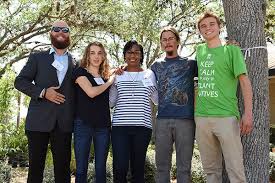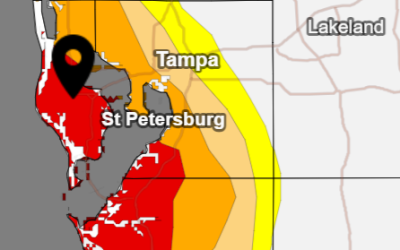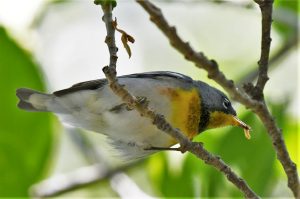Native landscaping as a sustainable practice provides for lower maintenance with reduced inputs such as pruning, fertilizer, water, and pesticide use. It may be as easy as replacing high input lawn areas or shifting your mindset to attract, conserve and sustain wildlife and provide a sense of place, the ‘REAL FLORIDA’. A more natural landscape model will provide its’ owner with the best possibilities for aesthetics, improved maintenance regiments, and an incredible life giving dynamic to enjoy.
Right Plant, Right Place
Native landscaping relies on the principle of ‘Right Plant, Right Place’. A good basis to plant selections is to determine, as best as possible, the original plant community that your property occupied, acknowledging that natural conditions such as soil, drainage, ph, or other factors have often been altered by fill and other disturbances. Relic mature trees and plants seen growing in your immediate location may be indicators of the original habitat. You may want to view maps such as the one seen in Xeric Landscaping with Florida Native Plants published by the FANN organization (formerly AFNN) to make this determination. The Xeric Landscape guide and other resources such as Florida Wildflowers in their Natural Communities by Walter Taylor list plants appropriate for Florida’s major plant community classifications.
Designing Native Landscaping
Designing a natural landscape becomes a meld of art and nature. Styling can vary greatly in interpretation from formal to total randomness. Too much randomness does not necessarily reflect the order seen in nature or comfort the innate human need for uniformity and control as well as help comply with community landscape ordinances or HOA rules. Adopting some traditional guidelines of landscape design will help you to develop a more pleasing landscape end result that will be appreciated by you and your neighbors. Before you start, it is a good idea to know the ordinances and rules in place for your location.
Preliminary consideration is needed to identify the ways your property will be used. Are there view lines you want to maintain or buffer and block? Will you want to reserve spaces for kitchen gardening, a play area, nectar gardening, water features, parking, patios, or a comfortable area in the landscape for repose or wildlife viewing. Note the natural flow of how foot traffic naturally moves through your property. This will help to develop pathways for egress through your property with possible stop-off points or vignettes for sitting areas in the landscape. Sitting areas and appropriate art pieces throughout areas of the landscape provide humanizing warmth and personality to a property. Voids in the landscape plantings can also have its’ own aesthetic value. You are investing in the landscape and drawing wildlife to view, so you want to have view lines from windows and spaces in the landscape to interact and enjoy your investment!
Selecting the Right Plants
Once you have identified the plant community or conditions of your property and the ways your property design needs to function for your needs and desires, make lists of plants you may want included in your design and start with rough outlines of traffic flow and uses on the property. To quote the Father of Landscape Architecture, Frederick Law Olmsted, “All rational improvement of grounds is, necessarily, founded on a due attention to the character and situation of the place to be improved”.
Biodiversity of native plants in our yard is great for supporting many species of pollinators, songbirds, butterflies and other wildlife as well as reducing exposure in the landscape to pests and diseases. Although monocultures should be avoided, be mindful that there are other goals of order in landscape design to consider for an aesthetic balance as we map a plan for our yards.
Front yard landscapes are our public view and as such, benefit from a more disciplined sense of design and curb appeal that will seem socially acceptable to most neighbors, friends, and family. Again, be mindful of local landscape restrictions in development of the landscape. There is nothing pleasant about a landscape that becomes contentious with the community. Our landscapes should provide examples to our neighbors, friends, and family of a pleasantly sustainable and dynamic way to live.
Every natural area or plant community is dominated by a set of plants that reflect the character or theme of the plant community and that particular geographical location. These natural features can be imitated in the design of our own landscapes. A thematic repetition of plants will provide a sense of organization to a landscape. Not all plants need to be repeated, but at least a couple of the species repeated will provide this effect. A rhythm of three or more points of repetition can give a nice flow and readability to the landscape.
Proper Plant Placement
A beginning concept of natural landscape planning is to liberate the plants from the shoe horn effect of tight spacing against the foundation of the home or building and tightly spaced layers. Moving the plants and plant beds into the open landscape or further out from the foundation is healthier for the plants and the structure. This combined with spacing the plants appropriately should allow for the natural growth features of the individual species. When the landscape is loosened up and pulled out away from the house, it can still effectively soften the structure as well as help in the end goal of reducing lawn area. To quote author, Margie Ruddeck, ‘Wild by Design’, the landscape should not be just the “parsley around the pig”.
This expresses an important point about natural landscaping and maintenance. When your landscaping is planned, and spaced correctly to allow for natural growth features of the plants selected, the plants reflect the character of their species allowing them to flower and fruit and function as ecological entities. In many typical landscapes, these features are being boxed and pruned away! One of the worst developments in landscape maintenance was power equipment, which has all but eliminated the art of gardening.
Create Contrast and Layers
To develop a visually dynamic landscape, contrast your plants with natural foliage textures and foliage color. It should not necessarily be about the blooms! Too often, too much initial attention is given to color and specimen effect. Color and interest will come with augmenting other, more important choices of what works in the plant selections. Arranging and layering these features will help you to compose a rewarding landscape aesthetic. The father of Landscape Architecture, Frederick Law Olmsted, made the point that landscaping too centered on specimen effect is ‘offensive to good taste’. Landscaping should express the genius of the place and avoid decoration and embellishment that bore no natural relation to it.
Layering a property with canopy trees, understory trees, shrubs, accents and groundcover will duplicate the layers found in nature. Repeating at least some of the plants in the various layers of the landscape will provide an opportunity to bring order to the landscape design. Layers in the structure of your landscape will accommodate flight patterns of birds and allow for shelter, food, and nesting opportunities.
Line is a very important consideration in the arrangement of plants in your design. Grouping of plants in flowing lines and sweeps can provide a great aesthetic service and can move the eye through the landscape. Front layer plants can especially provide a framework on the landscape, like a frame on an art piece, and create a prominent line in the landscape. Line can serve to pull the eye or traffic in directions that you want to control with the design.
Maintaining Native Landscapes
Native or natural landscaping is not maintenance free! Don’t overwhelm your ability to do the watering and maintenance for establishment. Initial maintenance is always the most intense in the conversion from lawns with a bank of weed seeds waiting to be exposed for growth. Proper preparation is very important and incremental implementation is a great process for success. Invest in a well-designed landscape, initial maintenance, and the effort will pay off with reduced maintenance in the long run.
Selective pruning for maintaining plant sizes and density allows for retaining natural form of the plant and its ecological services. Selective pruning is also low input maintenance, if not a therapeutic exercise! A well planned mature landscape should ideally require a schedule of selective pruning no more than a couple of times a year. Forgo the torture to yourself as well as to the harshly pruned plants sheared to emulate the same effect as boxes or meatballs painted green!
Getting Started
A good way to start a landscape plan is to layout the existing features to scale, including structures, existing landscaping, etc. and then free hand, sketch the lines of flow for pathways and plantings in the property. You can then modify the shapes and start to fill in the detail of trees, plants, and specialty features.
Well placed trees or shrubs that provide food or shelter and water features can allow wildlife viewing from windows, patios, or other important viewing opportunities.
A native landscape will be a wildlife garden in its totality. Native canopy trees, understory trees, shrubs, grasses and wildflowers used throughout a property as opposed to a token few or just a small concentrated bird or butterfly garden, will function to make a property have a of life giving dynamic that provides interest 365 / 24 /7!!!
Do not be intimidated by the process of planning and implementing a landscape plan. This should be a fun process! Although we attempt to plan for great outcomes, some failures do happen even in the most well planned landscapes. Be prepared to budget for needed replacements and changes. You are working with nature, so don’t feel defeated in small miscalculations.
Help Is Available
When planning your landscape you have the option of professional help or using the many resources to help you plan a great native landscape. Utilize the Florida Native Plant Society as a resource and become a member. There are also other online resources such as Tampa Bay resident, Craig Huegel’s Hawthorn Hill blog, , the Florida Native Plant Society articles and links, the Florida Association of Native Nurseries articles and links, and many, many more great on line resources. And don’t forget about us. Please visit Wilcox Nursery and Landscape at www.WilcoxNursery.com for more resources and information about our services. We are ready help when you’re ready to get started.





